Articles, In the Press, Resources, Yoga Medicine® News
My Favorite Non-Traditional Yoga Prop: Five Reasons to Practice Yoga with Resistance Bands
By Amanda Burks for Yoga Medicine®.

You may be familiar with resistance bands from physical therapy or fitness classes, but have you ever considered using them in your yoga asana practice? Studies continue to demonstrate the benefits of resistance band training across demographics—ranging from children to seniors—and nearly everyone in between. Given their accessibility and versatility, resistance bands can accompany a wide range of movement, making them a well-suited prop for yoga asana. Practicing yoga with resistance bands can help build strength, diversify movement patterns, explain biomechanics, and offer tactile feedback and assists, all for a relatively low cost.
With those benefits in mind, you may want to add a few resistance bands to your collection of yoga props. Read on to learn more, and try the accompanying practices, noting any new information the resistance bands offer you along the way.
1. Build Strength
Strength is a measure of force production. It is your body’s response to doing something effortful. Typically, strengthening practices involve creating force against an external load, such as, weights, kettlebells, or resistance bands. You can become stronger by lifting heavy loads, lifting light loads with many repetitions, or by moving rapidly under light load.
In yoga asana, we are typically producing force against a certain percentage of our that varies from pose to pose. For a beginner, yoga asana alone may be a strengthening practice if the percentage of bodyweight lifted is effortful. But for the experienced practitioner, it is unlikely that yoga asana will increase strength because as your familiarity increases, the effort required decreases. And while there can be a lot of repetition in yoga asana, it unlikely that enough repetitions are performed to invoke lasting adaptations.
However, when we use traditional weights or resistance bands in our yoga asana practice, our bodies are required to do more to manage the external load. This increased effort can transform yoga asana into a strengthening practice. While we can practice yoga with dumbbells, the creativity of our movement is limited because the weights must travel in a precise path, against gravity to produce resistance. Elastic resistance bands are unique in that resistance can be developed in any direction the band is elongated [1]. This quality makes resistance bands a versatile yoga prop to add to your collection.
One of my favorite resistance band strength practices is designed for the hamstrings and mimics the movement you may have experienced on a machine at the gym. Lying prone, and tucking your heels under a lever, you lift weight connected to the machine as you bring your heels toward your hips. You can create this same exercise with just one or two resistance bands. Start with a long resistance band with a small loop tied at each end. Place one loop around your foot and the other loop around your hand on the same side. Come into a prone position. Rest your head on one cheek or lift your torso into Sphinx pose (salamba bhujangasana) by placing your elbows under your shoulders. Bend your knee to bring your heel toward your glutes. Then lower your foot back to the floor. Repeat this movement between 20-30 times or until you become fatigued. You can also increase the challenge by adding another looped bad around the same foot, but opposite hand, as seen here. Just make sure to place your knee between the two long bands as you come into your prone position. As a third option, you could place one small looped band around both feet. Lying prone, keeping one foot on the floor, bend one knee to create the same movement as previously described.
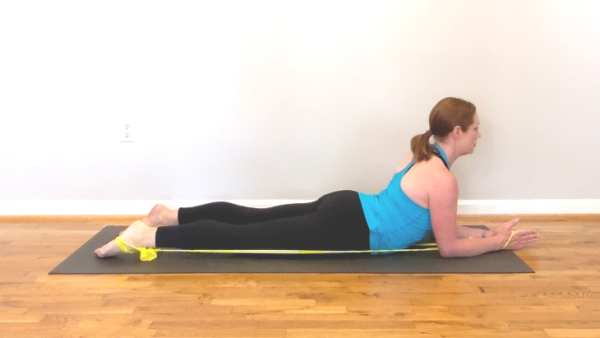
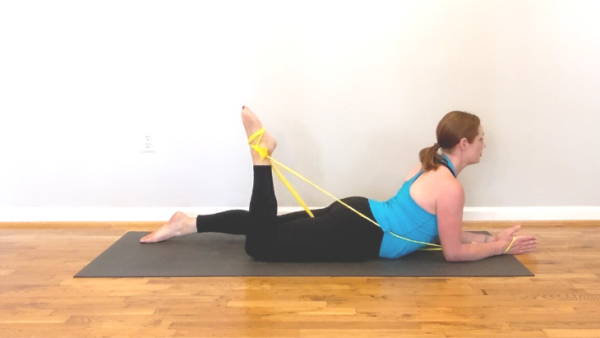
2. Diversify Your Movement Practice
From table pose to handstand, yoga offers a variety of poses that involve pushing the hands into the floor. However, a well-rounded movement practice should counter all that pushing with some pulling. But yoga asana cannot offer any pulling movement. Fortunately, resistance bands offer a way to incorporate pulling patterns into your movement practice.
One of my favorite pulling practices involves placing a long resistance band around my feet in Seated Staff pose (dandasana). With one end of the band in each hand, bend the elbows in a rowing pattern while hugging them in toward the sides. This seated row is a great complement to chaturanga dandasana.
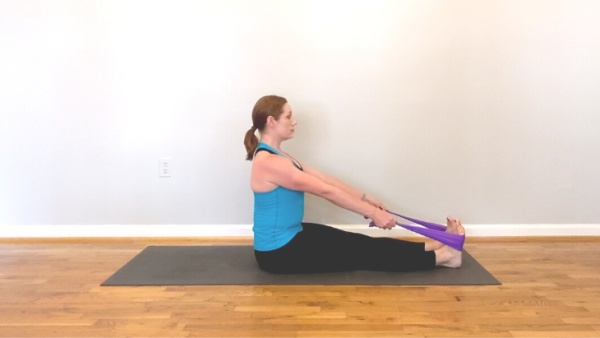
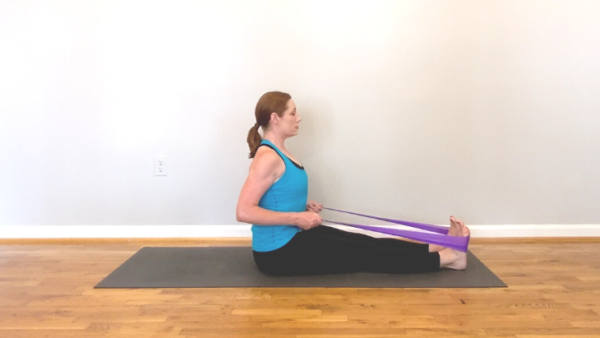
3. Understand Your Biomechanics
Because yoga is a deeply personal practice, we often feel sensations stronger in one part of the body—and perhaps not so much in others. It’s easy to have our attention monopolized by those louder sensations. But what is happening elsewhere?
For example, in Warrior 3 (virabhadrasana III) some feel nearly all the sensation is concentrated in the standing leg and hip, with little thought given to the lifted leg or the arms. Try placing one long resistance band, with loops tied at each end, around the lifted foot and the other end on the same side hand and you enter Warrior 3. You may be able to notice the sensations traveling along the band from you lifted leg, through your core and into your arms. For a deeper sensation, you can loop two bands around the lifted foot and the other ends around each hand as seen here.
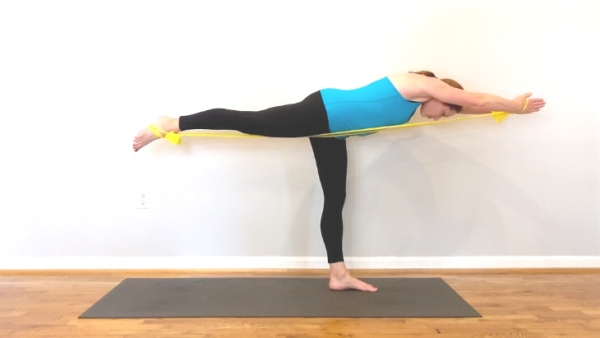
4. Resistance as Assistance
Before the pandemic, I appreciated hands-on assists in my yoga classes. Sometimes the cues just didn’t land with me and I needed to be physically moved in order to find the intended sensation of the pose. When I began practicing online, I missed that tactile feedback and often struggled to feel the stretch or challenge of a pose.
Around the same time, I began using resistance bands in my practice. Often times the bands remind me of a hands-on assist. We often think about pushing back against the band to build strength. But in many instances, the resistance bands can act as assistance bands to help lift you or encourage you to activate certain muscles. For example, I enjoy using a looped band around my upper arms in chaturanga dandasana. Beginning in High Plank, I feel the muscles of my posterior shoulders activate in response to the band. As a lower my upper body down in chaturanga dandasana, the band creates a hammock to hold my ribs, gently telling me when to stop. As I lift into Upward Facing Dog, the same band prevents my ribs from flaring. And as I transition back to Downward Dog, the band once again creates a hammock—but this time to hold my head, allowing me to soften the sides of my neck.
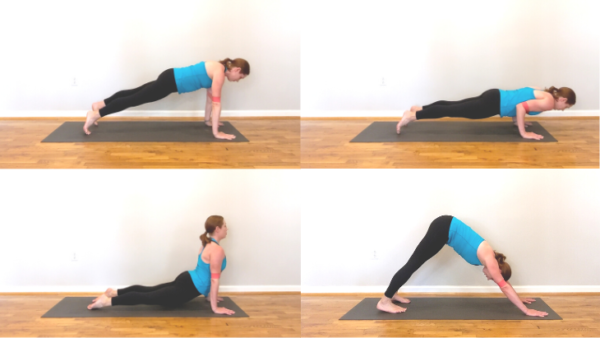
5. Accessibility
Resistance bands are relatively inexpensive, and are available for purchase at a variety of locations. You need not commit to the cost associated with a gym membership or expensive weights. Because they take up very little space, you can store your bands just about anywhere, and easily bring them along when you travel.
References:
- Picha KJ, Almaddah MR, Barker J, Ciochetty T, Black WS, Uhl TL. Elastic Resistance Effectiveness on Increasing Strength of Shoulders and Hips. J Strength Cond Res. 2019 Apr;33(4):931-943. doi: 10.1519/JSC.0000000000002216. PMID: 28922213; PMCID: PMC5847412.












